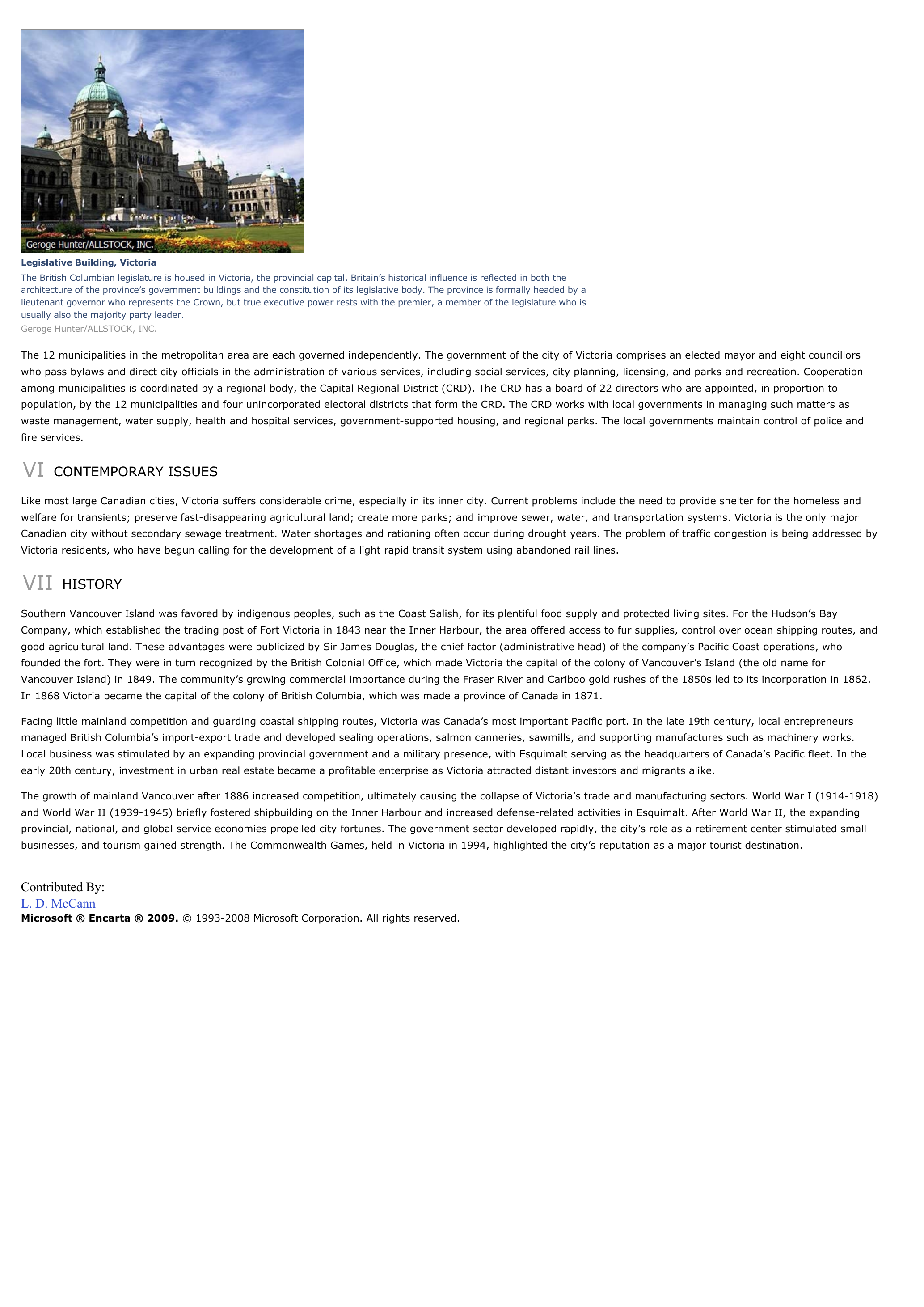Victoria (city, British Columbia) - geography.
Publié le 26/05/2013

Extrait du document
«
Legislative Building, VictoriaThe British Columbian legislature is housed in Victoria, the provincial capital.
Britain’s historical influence is reflected in both thearchitecture of the province’s government buildings and the constitution of its legislative body.
The province is formally headed by alieutenant governor who represents the Crown, but true executive power rests with the premier, a member of the legislature who isusually also the majority party leader.Geroge Hunter/ALLSTOCK, INC.
The 12 municipalities in the metropolitan area are each governed independently.
The government of the city of Victoria comprises an elected mayor and eight councillorswho pass bylaws and direct city officials in the administration of various services, including social services, city planning, licensing, and parks and recreation.
Cooperationamong municipalities is coordinated by a regional body, the Capital Regional District (CRD).
The CRD has a board of 22 directors who are appointed, in proportion topopulation, by the 12 municipalities and four unincorporated electoral districts that form the CRD.
The CRD works with local governments in managing such matters aswaste management, water supply, health and hospital services, government-supported housing, and regional parks.
The local governments maintain control of police andfire services.
VI CONTEMPORARY ISSUES
Like most large Canadian cities, Victoria suffers considerable crime, especially in its inner city.
Current problems include the need to provide shelter for the homeless andwelfare for transients; preserve fast-disappearing agricultural land; create more parks; and improve sewer, water, and transportation systems.
Victoria is the only majorCanadian city without secondary sewage treatment.
Water shortages and rationing often occur during drought years.
The problem of traffic congestion is being addressed byVictoria residents, who have begun calling for the development of a light rapid transit system using abandoned rail lines.
VII HISTORY
Southern Vancouver Island was favored by indigenous peoples, such as the Coast Salish, for its plentiful food supply and protected living sites.
For the Hudson’s BayCompany, which established the trading post of Fort Victoria in 1843 near the Inner Harbour, the area offered access to fur supplies, control over ocean shipping routes, andgood agricultural land.
These advantages were publicized by Sir James Douglas, the chief factor (administrative head) of the company’s Pacific Coast operations, whofounded the fort.
They were in turn recognized by the British Colonial Office, which made Victoria the capital of the colony of Vancouver’s Island (the old name forVancouver Island) in 1849.
The community’s growing commercial importance during the Fraser River and Cariboo gold rushes of the 1850s led to its incorporation in 1862.In 1868 Victoria became the capital of the colony of British Columbia, which was made a province of Canada in 1871.
Facing little mainland competition and guarding coastal shipping routes, Victoria was Canada’s most important Pacific port.
In the late 19th century, local entrepreneursmanaged British Columbia’s import-export trade and developed sealing operations, salmon canneries, sawmills, and supporting manufactures such as machinery works.Local business was stimulated by an expanding provincial government and a military presence, with Esquimalt serving as the headquarters of Canada’s Pacific fleet.
In theearly 20th century, investment in urban real estate became a profitable enterprise as Victoria attracted distant investors and migrants alike.
The growth of mainland Vancouver after 1886 increased competition, ultimately causing the collapse of Victoria’s trade and manufacturing sectors.
World War I (1914-1918)and World War II (1939-1945) briefly fostered shipbuilding on the Inner Harbour and increased defense-related activities in Esquimalt.
After World War II, the expandingprovincial, national, and global service economies propelled city fortunes.
The government sector developed rapidly, the city’s role as a retirement center stimulated smallbusinesses, and tourism gained strength.
The Commonwealth Games, held in Victoria in 1994, highlighted the city’s reputation as a major tourist destination.
Contributed By:L.
D.
McCannMicrosoft ® Encarta ® 2009. © 1993-2008 Microsoft Corporation.
All rights reserved..
»
↓↓↓ APERÇU DU DOCUMENT ↓↓↓
Liens utiles
- Victoria (city, British Columbia) - Geography.
- British Columbia - Geography.
- Vancouver (British Columbia) - Geography.
- Vancouver (British Columbia) - geography.
- British Columbia - Facts and Figures.

































